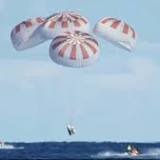Scientists Detect Water on the Surface of Asteroids for the First Time Ever


In a cosmic first, scientists have discovered water on the surface of two asteroids. The findings, published Monday in The Planetary Science Journal, chart new territory in understanding how the life-sustaining molecule is distributed throughout the solar system—and hint at how it ended up on Earth.
Scientists at the Southwest Research Institute detected the water molecules using data collected by the now-defunct Stratospheric Observatory for Infrared Astronomy (SOFIA), a Boeing airplane modified to carry a telescope that made its final flight in 2022.
Previously, other researchers used an instrument on SOFIA to examine particular wavelengths of light, called spectral signatures, emitted by molecules on the moon. In 2020, they spotted a specific wavelength unique to water molecules, revealing enough water on the moon’s sunlit surface to fill a 12-ounce bottle.
Inspired by this research, “we thought we could use SOFIA to find this spectral signature on other bodies,” says Anicia Arredondo, lead author of the new study and an asteroid researcher at the Southwest Research Institute, in a statement.
The scientists studied SOFIA’s observations of four asteroids rich in silicate, or minerals containing silicon and oxygen. Two of the asteroids, named Iris and Massalia, were found to emit the unique wavelength that “unambiguously” indicated the presence of water molecules, Arredondo says in the statement.
Iris and Massalia, which measure 124 miles and 84 miles in diameter, respectively, formed relatively close to the sun. According to the study, their water could be stored in multiple ways: The molecules could be trapped in beads of silicate glass or stuck to the silicates’ surface. Or, in a manner similar to the moon’s sunlit surface, where the molecular water was found within lunar soil, the asteroids’ water may be bound to minerals.
Though scientists have discovered water on asteroid samples brought to Earth through return missions, water molecules had never before been identified on asteroids still floating in space, writes Space.com’s Samantha Mathewson. Finding molecular water on Iris and Massalia, in particular, suggests liquid water can exist for eons on space rocks in the inner solar system—contrary to previous assumptions that any water would have evaporated from these asteroids under the heat of the sun.
“Asteroids are leftovers from the planetary formation process, so their compositions vary depending on where they formed in the solar nebula,” says Arredondo in the statement. “Of particular interest is the distribution of water on asteroids, because that can shed light on how water was delivered to Earth.”
The finding bolsters support for the popular theory that water did not originate on Earth, but rather crashed onto the planet through an asteroid impact.
“Asteroids, comets and their associated dust and debris are continually being nudged around by the gravity of the planets—changing the paths they follow through space,” Jonti Horner, an astrophysicist at the University of Southern Queensland in Australia, tells Newsweek’s Jess Thomson.
Knowledge of the composition of asteroids helps explain how materials within the inner solar system are distributed, according to the study. Understanding where water is located within our solar system could provide insight into how the substance is distributed in others.
“Because water is necessary for all life on Earth, [it] will drive where to look for potential life, both in our solar system and beyond,” according to the statement.
While the researchers found signs of water on Iris and Massalia, the other two asteroids they examined gave inconclusive results. Next, the team plans to use the James Webb Space Telescope to take a higher-resolution look at these bodies, then expand their search to even more asteroids.
“We have another proposal in for the next cycle to look at another 30 targets [with Webb],” adds Arredondo in the statement. “These studies will increase our understanding of the distribution of water in the solar system.”
Get the latest stories in your inbox every weekday.


 United Kingdom
United Kingdom Argentina
Argentina  Australia
Australia  Austria
Austria  Brazil
Brazil  Canada
Canada  Germany
Germany  Ireland
Ireland  Italy
Italy  Malaysia
Malaysia  Mexico
Mexico  New Zealand
New Zealand  Poland
Poland  South Africa
South Africa  United States
United States 
























